Lukas T. N. Landau
Symbol-Error Probability Constrained Power Minimization for Reconfigurable Intelligent Surfaces-based Passive Transmitter
Nov 12, 2023Abstract:This study considers a virtual multiuser multiple-input multiple-output system with PSK modulation realized via the reconfigurable intelligent surface-based passive transmitter setup. Under this framework, the study derives the formulation for the union-bound symbol-error probability, which is an upper bound on the actual symbol-error probability. Based on this, a symbol-level precoding power minimization problem under the condition that the union-bound symbol-error probability is below a given requirement is proposed. The problem is formulated as a constrained optimization on an oblique manifold, and solved via a bisection method. The method consists of successively optimizing transmit power while evaluating the feasibility of the union-bound symbol-error probability requisite by solving, via the Riemannian conjugate gradient algorithm, an auxiliary problem dependent only on the reflection coefficients of the reconfigurable intelligent surface elements. Numerical results demonstrate the effectiveness of the proposed approach in minimizing the transmit power for different symbol-error probability requirements.
State Machine-based Waveforms for Channels With 1-Bit Quantization and Oversampling With Time-Instance Zero-Crossing Modulation
Feb 04, 2023Abstract:Systems with 1-bit quantization and oversampling are promising for the Internet of Things (IoT) devices in order to reduce the power consumption of the analog-to-digital-converters. The novel time-instance zero-crossing (TI ZX) modulation is a promising approach for this kind of channels but existing studies rely on optimization problems with high computational complexity and delay. In this work, we propose a practical waveform design based on the established TI ZX modulation for a multiuser multi-input multi-output (MIMO) downlink scenario with 1-bit quantization and temporal oversampling at the receivers. In this sense, the proposed temporal transmit signals are constructed by concatenating segments of coefficients which convey the information into the time-instances of zero-crossings according to the TI ZX mapping rules. The proposed waveform design is compared with other methods from the literature. The methods are compared in terms of bit error rate and normalized power spectral density. Numerical results show that the proposed technique is suitable for multiuser MIMO system with 1-bit quantization while tolerating some small amount of out-of-band radiation.
Multiuser-MIMO Systems Using Comparator Network-Aided Receivers With 1-Bit Quantization
Nov 18, 2022Abstract:Low-resolution analog-to-digital converters (ADCs) are promising for reducing energy consumption and costs of multiuser multiple-input multiple-output (MIMO) systems with many antennas. We propose low-resolution multiuser MIMO receivers where the signals are simultaneously processed by 1-bit ADCs and a comparator network, which can be interpreted as additional virtual channels with binary outputs. We distinguish the proposed comparator networks in fully and partially connected. For such receivers, we develop the low-resolution aware linear minimum mean-squared error (LRA-LMMSE) channel estimator and detector according to the Bussgang theorem. We also develop a robust detector which takes into account the channel state information (CSI) mismatch statistics. By exploiting knowledge of the channel coefficients we devise a mean-square error (MSE) greedy search and a sequential signal-to-interference-plus-noise ratio (SINR) search for optimization of partially connected networks. Numerical results show that a system with extra virtual channels can outperform a system with additional receive antennas, in terms of bit error rate (BER). Furthermore, by employing the proposed channel estimation with its error statistics, we construct a lower bound on the ergodic sum rate for a linear receiver. Simulation results confirm that the proposed approach outperforms the conventional 1-bit MIMO system in terms of BER, MSE and sum rate.
MMSE Symbol Level Precoding Under a Per Antenna Power Constraint for Multiuser MIMO Systems With PSK Modulation
Jun 25, 2022
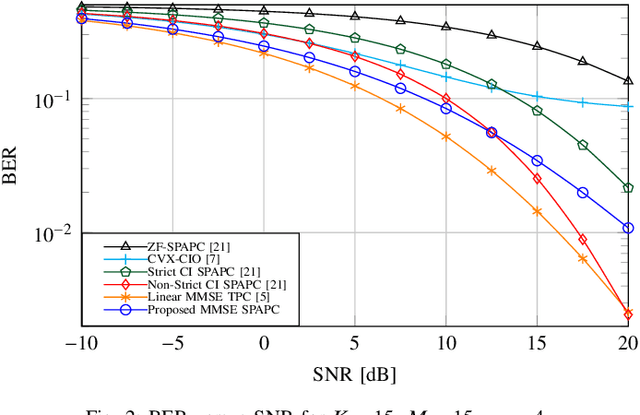
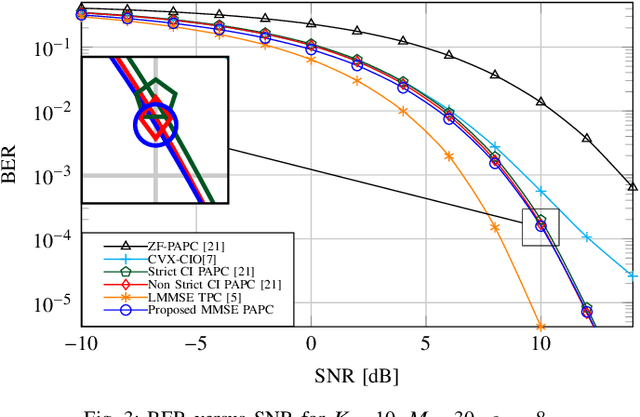
Abstract:This study proposes a symbol-level precoding algorithm based on the minimum mean squared error design objective under a strict per antenna power constraint for PSK modulation. The proposed design is then formulated in the standard form of a second-order cone program, allowing for an optimal solution via the interior point method. Numerical results indicate that the proposed design is superior to the existing approaches in terms of bit-error-rate for the low and intermediate SNR regime.
Minimum Symbol Error Probability Low-Resolution Precoding for MU-MIMO Systems With PSK Modulation
Oct 05, 2021


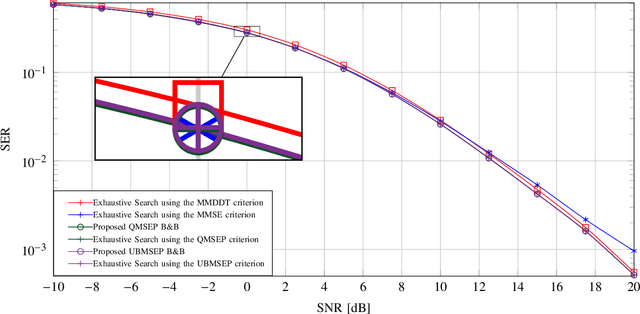
Abstract:We propose an optimal low-resolution precoding technique that minimizes the symbol error probability of the users. Unlike existing approaches that rely on QPSK modulation, for the derivation of the minimum symbol error probability objective function the current approach allows for any PSK modulation order. Moreover, the proposed method solves the corresponding discrete optimization problem optimally via a sophisticated branch-and-bound method. Moreover, we propose different approaches based on the greedy search method to compute practical solutions. Numerical simulations confirm the superiority of the proposed minimum symbol error probability criteria in terms of symbol error rate when compared with the established MMDDT and MMSE approaches.
Discrete MMSE Precoding for Multiuser MIMO Systems with PSK Modulation
May 24, 2021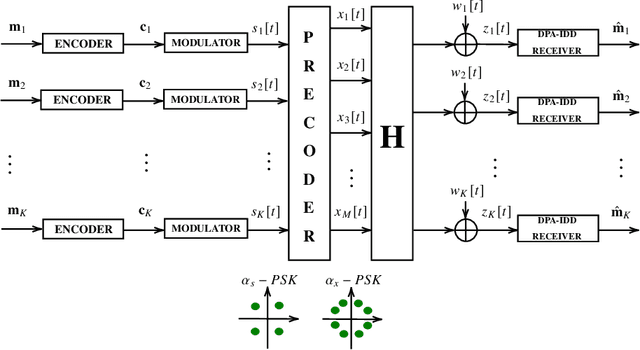


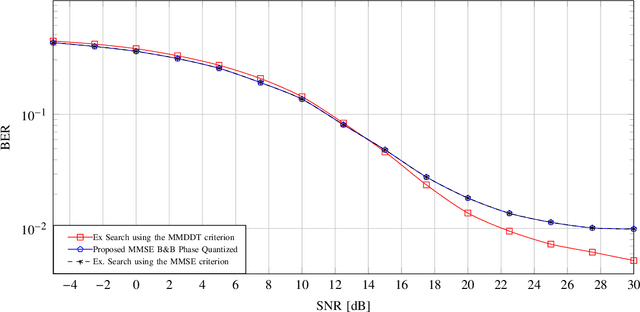
Abstract:We propose an optimal MMSE precoding technique using quantized signals with constant envelope. Unlike the existing MMSE design that relies on 1-bit resolution, the proposed approach employs uniform phase quantization and the bounding step in the branch-and-bound method is different in terms of considering the most restrictive relaxation of the nonconvex problem, which is then utilized for a suboptimal design also. Moreover, unlike prior studies, we propose three different soft detection methods and an iterative detection and decoding scheme that allow the utilization of channel coding in conjunction with low-resolution precoding. Besides an exact approach for computing the extrinsic information, we propose two approximations with reduced computational complexity. Numerical simulations show that utilizing the MMSE criterion instead of the established maximum-minimum distance to the decision threshold yields a lower bit-error-rate in many scenarios. Furthermore, when using the MMSE criterion, a smaller number of bound evaluations in the branch-and-bound method is required for low and medium SNR. Finally, results based on an LDPC block code indicate that the receive processing schemes yield a lower bit-error-rate compared to the conventional design.
 Add to Chrome
Add to Chrome Add to Firefox
Add to Firefox Add to Edge
Add to Edge